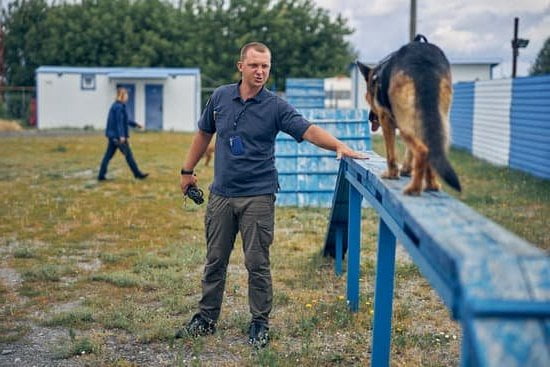Is your dog constantly running away when you call them outside? In this article, we will discuss how to train a dog to come to you outside. Teaching your dog to come when called is not only a matter of obedience, but also a crucial aspect of their safety and well-being. Before diving into specific training techniques, it’s important to understand why this skill is essential for every dog owner.
Building a strong foundation is key when it comes to training your dog to come when called. This includes teaching them basic commands such as sit and stay, which are fundamental for building trust and communication between you and your canine companion. Additionally, finding the right training environment is crucial in order to minimize distractions and set your dog up for success.
Using positive reinforcement, such as treats and verbal praise, can be incredibly effective in teaching your dog to come when called. It’s important to consistently reward their good behavior in order to reinforce the desired response. Additionally, utilizing training tools like a long line can provide both safety and control during the training process. By incorporating these techniques, you can ultimately enjoy the freedom of having your dog off-leash with confidence.
Building a Strong Foundation
When training a dog to come to you outside, it is essential to build a strong foundation by teaching basic commands like sit and stay. These fundamental commands lay the groundwork for more advanced training, including teaching your dog to come when called. By mastering these basic commands, your dog will learn self-control and responsiveness, making it easier to train them to come to you when they are off-leash.
When they lower their bottom to the ground, reward them with the treat and praise. For “stay,” ask your dog to sit and then hold out your hand in a stop signal while saying “stay.” Gradually increase the time they hold the position before rewarding them.
Consistency is key when teaching basic commands. Practice these exercises daily for short periods of time, gradually increasing the duration as your dog becomes more proficient. It is also important to keep training sessions positive and fun for your dog – this will help build a strong bond between you and make learning more enjoyable for them.
By establishing a solid foundation with these basic commands, you are paving the way for successful recall training. Remember that every dog learns at their own pace, so be patient and stay persistent in your training efforts. With time and dedication, you can set up your furry friend for success in coming when called outside.
Choosing the Right Training Environment
When it comes to training your dog to come to you outside, choosing the right training environment is crucial for success. Finding a distraction-free zone will help create the ideal conditions for teaching your dog this important command.
Eliminating Distractions
One of the key components in finding a distraction-free zone for training is to eliminate as many potential distractions as possible. This means choosing a location that is away from busy streets, other animals, and loud noises. A peaceful and quiet area will allow your dog to focus solely on you and the training session.
Enclosed Areas
Another helpful tip for finding a distraction-free zone is to utilize enclosed areas such as a fenced backyard or an empty field. These spaces provide a sense of security and reduce the likelihood of your dog wandering off or becoming too overwhelmed by external stimuli.
Time of Day
Finally, consider the time of day when choosing a training environment. Early morning or late evening sessions may be best to avoid encountering excessive foot traffic or other dogs in the area. By being mindful of these factors, you can create an optimal setting for teaching your dog how to come to you outside.
By understanding the importance of selecting the right training environment and implementing these tips, you can set yourself and your dog up for success when working on reliable recall exercises outdoors.
The Power of Positive Reinforcement
When it comes to training your dog to come to you outside, the power of positive reinforcement cannot be underestimated. Using treats and verbal praise is a highly effective method for teaching your dog to respond to your commands. Positive reinforcement creates a strong association between the desired behavior (coming when called) and a reward, making your dog more likely to repeat that behavior in the future.
Using Treats as a Reward
One of the most common and successful methods for training a dog to come to you outside is by using treats as a reward. Start by calling your dog’s name and when they come to you, immediately give them a treat.
It’s important to use high-value treats that your dog really loves, such as small pieces of cooked chicken or cheese. This will make the reward more enticing for your dog and increase their motivation to respond to your commands.
Verbal Praise and Affection
In addition to using treats, verbal praise and affection are also powerful forms of positive reinforcement. When your dog comes to you outside, be sure to shower them with praise in an upbeat tone of voice. Use phrases like “Good boy/girl.” or “Well done.” accompanied by petting and physical affection. This positive feedback will further strengthen the bond between you and your dog, making them more eager to follow your cues.
By consistently using treats and verbal praise as rewards for coming when called, you can effectively train your dog to respond reliably when outside. Remember that every dog is different, so be patient and stay consistent in your training efforts. With time and practice, using positive reinforcement will lead to a stronger recall response in various outdoor environments.
Training Tools
When training your dog to come to you outside, using a long line can be an essential tool for ensuring their safety and maintaining control during training sessions. A long line is a length of rope or nylon that allows you to give your dog more freedom while still keeping them within your reach. Here are some tips on how to effectively use a long line in your training:
- Choose the right long line: When selecting a long line, opt for one that is lightweight yet durable. It should be at least 20-30 feet long to provide your dog with enough space to roam while still allowing you to maintain control.
- Introduce the long line gradually: Before attaching the long line to your dog’s collar or harness, allow them to become familiar with it by letting them sniff and play with it. Gradually attach the line and let your dog drag it around under supervision before using it for training exercises.
- Use the long line during recall practice: When practicing recall exercises, such as calling your dog to come to you from a distance, use the long line as a safety measure. Allow your dog to roam freely while gradually increasing the distance between you and them. If needed, gently guide them towards you using the long line while reinforcing the “come” command.
By incorporating a long line into your training routine, you can effectively teach your dog reliable recall skills while keeping them safe and under control in outdoor environments. With consistency and patience, using this tool can help build trust and confidence in both you and your furry companion when venturing outside together.
Practice Makes Perfect
When it comes to training your dog to come to you outside, consistency and persistence are key. Repetition is crucial in reinforcing the command “come” and ensuring that your dog responds reliably in various situations. Here’s how to train a dog to come to you outside with consistency and persistence.
First, establish a consistent training routine. Set aside dedicated time each day to work on the “come” command with your dog. Whether it’s in your backyard, a local park, or any other safe outdoor space, make sure the environment is suitable for training without too many distractions.
During your training sessions, be persistent in your efforts. Use positive reinforcement techniques such as treats and verbal praise when your dog responds correctly to the “come” command. Remember that every interaction is an opportunity for training, so be consistent in reinforcing the behavior you want to see.
Additionally, make sure everyone in your household follows the same training methods and uses the same cues for the “come” command. Consistency among all family members will help reinforce the behavior and prevent confusion for your dog.
| Training Tips | Details |
|---|---|
| Consistent Routine | Set aside dedicated time each day for training sessions. |
| Positive Reinforcement | Use treats and verbal praise to reward correct responses. |
| Consistency Among Family Members | Ensure everyone follows the same training methods and uses consistent cues. |
By consistently practicing the “come” command with persistence, you can help your dog learn to come to you outside reliably. Remember that every interaction with your dog is an opportunity for training, so stay patient and dedicated in your efforts. In doing so, you’ll soon enjoy the freedom of having a well-trained canine companion who responds promptly when called – even in outdoor settings with distractions.
Troubleshooting
Training your dog to come to you outside can be a challenging task, as there are many distractions that can divert your pet’s attention. It is important to recognize and address these common challenges in order to ensure successful training.
One common challenge is when a dog becomes fixated on something else, such as another animal or an interesting scent, and refuses to respond to the recall command. Another challenge may arise if the dog has had negative experiences with coming when called, leading to a lack of trust in the owner’s intentions.
One effective way to address these challenges is by gradually increasing the level of distraction during training sessions. Start with simple environments with minimal distractions and gradually progress to more stimulating settings as your dog becomes more reliable in responding to your recall command. Additionally, it is crucial to maintain a positive and patient attitude during training. Punishment or scolding for not obeying the recall command can cause anxiety in your pet, making training even more difficult.
Furthermore, it is important to consider your dog’s individual temperament and personality when troubleshooting challenges during training sessions. Understanding what motivates and excites your pet can help you tailor your training approach accordingly. By being flexible and adapting your strategies based on your dog’s behavior, you will be better equipped to overcome common challenges and distractions when teaching your dog to come when called outside.
| Common Challenges | How to Address |
|---|---|
| Dog fixated on something else | Gradually increase distraction levels during training |
| Negative experiences with recall command | Maintain positive and patient attitude during training |
| Varying temperaments and personalities of dogs | Tailor training approach based on individual behavior |
Taking Training to the Next Level
Once your dog has mastered the basic commands of sit, stay, and come, it’s time to take their training to the next level. Adding distance and reliable recall exercises will help ensure that your dog comes to you outside no matter where you are.
To start, continue practicing in a distraction-free zone but gradually increase the distance between you and your dog when calling them to come. Use a long line for safety and control as you begin practicing in different environments such as a park or a quiet street. It’s important to reinforce the command with positive reinforcement using treats and verbal praise every time your dog successfully comes to you.
As with any training, consistency and persistence are key. Keep practicing these exercises regularly so that your dog becomes more reliable in responding to your calls, even when they are at a distance from you. This will build their confidence and trust in you as their handler, making them more likely to come when called no matter where they are.
Remember that each dog is unique, so be patient and understand that some dogs may require more time than others to master these exercises. If challenges or distractions arise during training, troubleshoot by going back to basics and slowly reintroducing the exercises in different environments until your dog becomes more reliable in their recall. With dedication and patience, taking your dog off-leash with confidence is achievable.
Enjoying the Fruits of Your Labor
In conclusion, training your dog to come to you outside is not only a matter of convenience but also a critical aspect of their safety and well-being. By building a strong foundation with basic commands like sit and stay, choosing the right training environment, and utilizing the power of positive reinforcement, you can set your dog up for success in learning to come when called.
Additionally, using training tools such as a long line for safety and control can provide an extra layer of security as your dog gains confidence in their recall abilities.
Consistency and persistence are crucial when it comes to training your dog to come to you outside. By practicing regularly and addressing common challenges and distractions, you can help your dog develop a reliable recall no matter the situation. Taking training to the next level by adding distance and reliable recall exercises will further solidify your dog’s understanding of this important command.
Ultimately, the goal is to enjoy the fruits of your labor by taking your dog off-leash with confidence. With patience and dedication, you can have peace of mind knowing that your furry companion will reliably return to you no matter the circumstances. So, whether it’s for playtime at the park or enjoying nature on a hike, training your dog to come to you outside will strengthen the bond between you and ensure their safety in various environments.
Frequently Asked Questions
How Do You Train Your Dog to Come to You When Outside?
Training your dog to come to you when outside involves using positive reinforcement, such as treats or praise, when they respond to the “come” command. Start in a quiet area and gradually increase distractions as they improve.
What to Do When Your Dog Won’t Come in From Outside?
If your dog won’t come in from outside, avoid chasing them as it can turn into a game. Instead, try using their favorite toy or treat to lure them indoors. Consistency and patience are key in reinforcing the “come” command.
What Do You Do When Your Dog Won’t Come When Called?
When your dog won’t come when called, it’s important not to scold or punish them as it can create a negative association with the command. Instead, go back to basic training and practice the “come” command in different environments with positive reinforcement.

Welcome to the blog! I am a professional dog trainer and have been working with dogs for many years. In this blog, I will be discussing various topics related to dog training, including tips, tricks, and advice. I hope you find this information helpful and informative. Thanks for reading!





